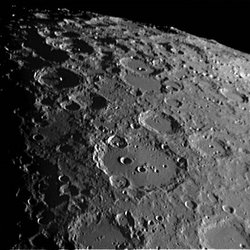
Paul Campbell took this amazing picture of the Moon. Image credit: Paul Campbell. Click to enlarge.
ILEWG is a public forum sponsored by the world’s space agencies to support “international cooperation towards a world strategy for the exploration and utilization of the Moon – our natural satellite”. An example objective is the ready and free sharing of data to any and all parties. This allows for judicious review and most importantly avoids duplication. Also, by coordinating onboard experiments beforehand, agencies can avoid duplicating research and wasting scarce funding. Given the costs and risks associated with each expedition, together with the scarcity of public funds, avoiding duplication is a necessary goal.
Exploring the Moon never stopped after the Apollo program. However, researchers have had to fight for funding on an equal basis with every other government department. In consequence, the number of missions have been few and far between. Now, only one satellite, Smart-1, orbits the Moon. This will change. For returning to the Moon, setting up a base, and then continuing on to Mars, we will need to know more of the Moon to minimize the cost and maximize the benefit. The Holy Grail for lunar exploration is water ice. Finding sufficient, recoverable quantities would greatly facilitate a human presence (as in drinking water) and further exploration (as in rocket fuel production). Without water ice, we either use brute force to raise sufficient quantities out of Earth’s gravity well or invent new techniques. Both these represent signficantly greater challenges. Nevertheless, the researchers at ILEWG are well aware of their knowledge gaps and are actively preparing missions to fill these in.
Yet the ILEWG participants aren’t accepting the status quo with NASA being the only player in town. In addition to other national space agencies, there were many individuals and corporations who were promoting their own style of space exploration and utilization. Lunar telescopes, mines and tourist hotels were just some opportunities deemed potential. To facilitate these ventures, conference attendees were treated to lectures on property rights, the common heritage of humankind and investment financing. For instance, without any arbitration medium, imagine sitting at your new observatory on the moon only to feel blasting from a nearby mining operation! These additional conference contributors, and their ability to think outside the box, demonstrate the desire and ability of the big, independent players at ILEWG.
However, even though great thinkers and doers were present, this doesn’t guarantee a lunar ‘gold rush’ happening any time soon. After all, if there were quick riches to be made, we would have had colonies already turning the lunar regolith into Swiss cheese. Instead, we’ve had to rely on public funds, i.e. taxpayer’s dollars. And unless some unforeseen magic appears, we will need a huge amount of this money to build a suitable infrastructure to reliably establish a human presence on the Moon’s surface. This showcases one omission from ILEWG. Very little attention was given to promoting lunar and space activities to the general public. Given the incessant demand for public funds that comes from every quarter, there needs to be solid and continual vindication for lunar base allocations. Alongside the great thinkers and doers, we need exuberant public relations experts to sell this endeavour.
Without the public’s interest, we will neither establish lunar colonies nor ever move off of Earth. The preponderance of technical data and investigations at the ILEWG conference demonstrate that we have the technical ability. But where is the justification? There is precious little economic justification. The monetary cost and consumption of Earth’s natural resources for people to live and work on the Moon is far greater than the equivalent cost of doing business on Earth. Further, the Moon has no unique qualities, after all, the Moon’s surface is very similar to the Earth’s. So, though service and resource providers may facilitate lunar colonies, they will not economically create such a colony.
But I am a believer. We need to step off of Earth and give ourselves a future that encompasses more than this one planet. We know our planet’s environment changes drastically. We know large asteroids regularly pummel the Earth’s surface. We know our Sun’s radiation fluctuates and the Sun itself will undergo a final tumultuous collapse. Restricting our children to the confines of the Earth’s surface is an artificial limiter that prevents our species from being the best it can be. We can do better. So get involved, talk to people, remind them that space is still a new harsh environment onto which we have barely stepped. Make them believe in a future more challenging and rewarding than simply lying on the ground at night wondering what the shiny dots above might be.
Whether, homesteaders, governments or organizations are the instigators, the Moon is our stepping stone off the Earth. The organization ILEWG is helping coordinate research and exploration amongst nations to quicken the building of our society off world. The gravity well that is Earth will remain for as long as the Earth so let’s acknowledge this, not as a barrier, but as a test to our civilization. Let’s work together and pass this test and decide our future, or we will stay moribund on Earth waiting for the future to decide our fate.
Written by Mark Mortimer
